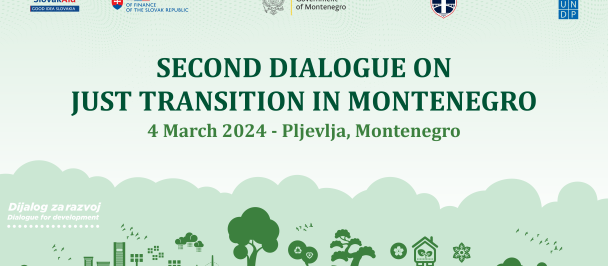Enhancing Montenegro’s capacity to integrate climate change risks into planning – National Adaptation Plan (NAP) project
Summary:
Climate change poses serious, wide-ranging risks to economies, societies and ecosystems. Reducing these risks requires action to sharply reduce greenhouse gas emissions (mitigation), combined with measures to increase resilience to the impacts that occur (adaptation). We have a once-in-a generation opportunity - through the Paris Agreement on Climate Change and Sustainable Development Goals (SDGs) - to ensure a more sustainable, equitable and prosperous future for all.
In many countries, Montenegro included, UNDP has an important role in work toward this future. We rely on strong expertise, experience and partnerships with national and international organisations and individuals to deliver this future. As a result of this cooperation with support of the Government of Montenegro on one side and Green Climate Fund on other side UNDP implements the project “Enhancing Montenegro’s capacity to integrate climate change risks into planning”.
The main beneficiaries of the project are ministries and institutions responsible for issues of sustainable development and tourism, agriculture and rural development, health, economy and finance and the Institute of Hydrometeorology and Seismology of Montenegro.
Objectives:
With the Green Climate Fund support, Montenegro will strengthen its institutional coordination framework, expanding the technical capacities of those responsible and involved in adaptation planning, enhance the evidence base required for effective decision making, and define a resource mobilization strategy, thus responding to gaps and barriers limiting functioning and effective adaptation planning process identified as:
- An underperforming coordination framework;
- A lack of institutional capacity;
- Insufficient information and lack of finance to fund adaptation investments;
- A private sector that has a low capacity to understand and respond to climate vulnerabilities and risks.
This project will help Montenegro lay the groundwork for systemic and iterative adaptation planning through the identification of climate risks and adaptation options for the purposes of having a well-established planning process that leads to improved resiliency growth. This strategic approach will, inter alia, boost Montenegro’s position vis-a-vis its development partners, international funding sources and the private sector as it relates to the provision of financial resources.
It is foreseen that this project will also strengthen the awareness and capacities for adaptation planning of multiple stakeholder groups which will create a better environment for learning and iterative adaptation planning and action.
Key activities:
- Capacity assessment of key stakeholders involved in the NAP process to determine individual and institutional capacity gaps that are key for integrating climate risks and adaptation into planning (e.g. climate information and risks, tools for integration, appraisal and prioritization of adaptation project options, project development, implementation, gender mainstreaming, etc.);
- Support the update the mission and mandate of the Working Group on Mitigation and Adaptation to Climate Change in order to appropriately include issues related to adaptation in order to enhance action, coordination, and accountability;
- Define the governing processes and institutional arrangements for oversight and coordination of adaptation related issues;
- Define a multi-stakeholder coordination mechanism that includes the private sector as well as women and other vulnerable groups;
- Define the frequency and timeframes of the NAP planning cycles and of the related monitoring and evaluation systems;
- Develop Standard Operating Procedures for coordination of adaptation plans and activities between sectors and agencies as well as among working groups at national and municipal levels;
- Undertake a comprehensive review and consolidation of available climate risks assessments within or related to the four priority sectors that includes an examination of the impacts on both public and private sectors assets and systems in the assessments;
- Develop gender-sensitive adaptation goals, targets and indicators for each of the four priority sectors;
- Finalize the NAP document based on the peer review and public comments;
- Define a sustainable finance sector investment strategy and roadmap to increase the private sector’s interest and engagement in adaptation. Part of the strategy will include identifying and presenting costs resulting from a lack of resilience, investment themes and areas that are of the most interest to private investors, exploring business models, and packaging and promoting these opportunities.
Expected results:
- Strengthened institutional coordination framework;
- Expanding the technical capacities of those responsible and involved in adaptation planning;
- Enhance the evidence base required for effective decision making;
- Resource mobilization strategy for adaptation interventions.
Ongoing activities and results:
- Outcome 1: Adaptation planning governance, institutional coordination, and technical capacity strengthened
This outcome will set the foundation for adaptation planning throughout the country. This will be achieved by establishing an institutional coordination mechanism with a clear and strong mandate, defining the roles of the participating institutions, and assessing and enhancing the capacity of these institutions.
- Output 1.1: Institutional capacity for adaptation planning assessed and enhanced.
Activities under this Output will undertake a detailed assessment of the capacities of the key institutions responsible for adaptation planning, develop and deliver a training programs to increase the capacity to understand climate risks and vulnerabilities and how to integrate adaptation into existing policies and planning.
- Output 1.2 Institutional coordination to support adaptation planning strengthened
Activities under this Output will engage key stakeholders in the NAP process, establish an information sharing platform to support the coordination of adaptation planning and actions, update the mission and mandate of the Working Group on Mitigation and Adaptation to Climate Change as it relates to adaptation in order to enhance action, coordination, and accountability.
- Outcome 2: An enhanced evidence base for designing gender-sensitive adaptation solutions
Under this outcome, existing information will be reviewed and appraised and additional assessments within the priority sectors will be undertaken, gender-sensitive adaptation options will be identified and prioritized, and a NAP policy document will be produced.
- Output 2.1 Gender-specific climate change-driven risks and vulnerabilities in priority sectors identified, broad goals and potential adaptation measures developed
Activities under this Output will conduct a comprehensive review, consolidation and synthesis of available climate-driven risks and vulnerabilities that relate to or are specifically focused on the 4 priority sectors.
- Output 2.2 National Adaptation Planning processes established
Activities under this Output will establish a team of multidisciplinary national/international expert consultants to draft the National Adaptation Plan, develop a 3-year work-plan for implementation of the NAP, establish a monitoring and evaluation framework for adaptation planning and its effectiveness and develop a Gender Action Plan to ensure gender mainstreaming features explicitly in the design and implementation of the NAP.
- Outcome 3: An adaptation finance mobilization strategy developed
This outcome will equip Montenegro with an enhanced understanding of the landscape of climate financing available for adaptation planning and enhance the evidence base that supports private investment in low-emission and climate-resilient development.
- Output 3.1 Mechanisms for funding adaptation investments identified
Activities under this Output will conduct a preliminary cost-benefit analysis for the sector-based adaptation goals.
- Output 3.2 Private sector engagement in adaptation strengthened
Activities under this Output will develop a financing strategy that maps to the prioritized adaptation goals and that identifies and considers the barriers that prevent private sector stakeholders (business, industry, banking, microfinance sectors) from engaging in low-emission and climate-resilient development.

 Locations
Locations

